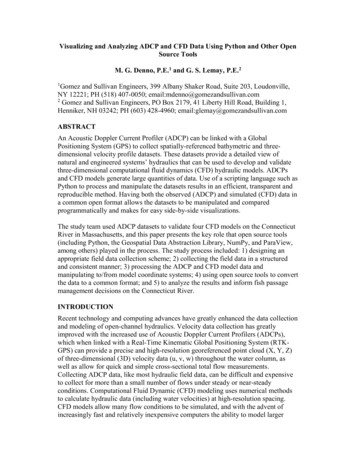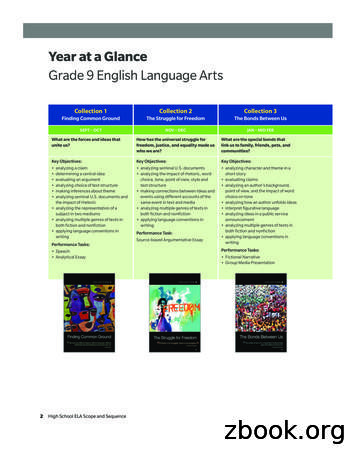Visualizing And Analyzing ADCP And CFD Data Using Python .
Visualizing and Analyzing ADCP and CFD Data Using Python and Other OpenSource ToolsM. G. Denno, P.E.1 and G. S. Lemay, P.E.21Gomez and Sullivan Engineers, 399 Albany Shaker Road, Suite 203, Loudonville,NY 12221; PH (518) 407-0050; email:mdenno@gomezandsullivan.com2Gomez and Sullivan Engineers, PO Box 2179, 41 Liberty Hill Road, Building 1,Henniker, NH 03242; PH (603) 428-4960; email:glemay@gomezandsullivan.comABSTRACTAn Acoustic Doppler Current Profiler (ADCP) can be linked with a GlobalPositioning System (GPS) to collect spatially-referenced bathymetric and threedimensional velocity profile datasets. These datasets provide a detailed view ofnatural and engineered systems’ hydraulics that can be used to develop and validatethree-dimensional computational fluid dynamics (CFD) hydraulic models. ADCPsand CFD models generate large quantities of data. Use of a scripting language such asPython to process and manipulate the datasets results in an efficient, transparent andreproducible method. Having both the observed (ADCP) and simulated (CFD) data ina common open format allows the datasets to be manipulated and comparedprogrammatically and makes for easy side-by-side visualizations.The study team used ADCP datasets to validate four CFD models on the ConnecticutRiver in Massachusetts, and this paper presents the key role that open source tools(including Python, the Geospatial Data Abstraction Library, NumPy, and ParaView,among others) played in the process. The study process included: 1) designing anappropriate field data collection scheme; 2) collecting the field data in a structuredand consistent manner; 3) processing the ADCP and CFD model data andmanipulating to/from model coordinate systems; 4) using open source tools to convertthe data to a common format; and 5) to analyze the results and inform fish passagemanagement decisions on the Connecticut River.INTRODUCTIONRecent technology and computing advances have greatly enhanced the data collectionand modeling of open-channel hydraulics. Velocity data collection has greatlyimproved with the increased use of Acoustic Doppler Current Profilers (ADCPs),which when linked with a Real-Time Kinematic Global Positioning System (RTKGPS) can provide a precise and high-resolution georeferenced point cloud (X, Y, Z)of three-dimensional (3D) velocity data (u, v, w) throughout the water column, aswell as allow for quick and simple cross-sectional total flow measurements.Collecting ADCP data, like most hydraulic field data, can be difficult and expensiveto collect for more than a small number of flows under steady or near-steadyconditions. Computational Fluid Dynamic (CFD) modeling uses numerical methodsto calculate hydraulic data (including water velocities) at high-resolution spacing.CFD models allow many flow conditions to be simulated, and with the advent ofincreasingly fast and relatively inexpensive computers the ability to model larger
systems in greater detail is continually improving. Comparing CFD model resultswith field observations is critical, however, to evaluate a model’s strengths andweaknesses and determine whether a model is appropriate for meeting studyobjectives. Using georeferenced 3D velocity observations from a combined RTKGPS/ADCP system to assess CFD model outputs is a sensible, effective, and detailedmethod to assess CFD model accuracy when combined with other traditional fielddata (e.g., water surface elevations, flow distributions, etc.).ADCP data and CFD outputs provide a detailed view of natural (e.g., streams andrivers) and engineered (e.g., canals, powerhouse intakes) open-channel systems’hydraulics. The vast amount of hydraulic data available allows engineers,environmental scientists, fisheries biologists, and others to visualize and study openchannel hydraulics at dams, road crossings, and other primarily-manmade structuresto help inform design decisions relative to fish passage, dam safety, bridge design,and numerous other purposes. This wealth of data, however, also brings about manychallenges in understanding and using it to make informed decisions.Fortunately, there are many available open-source tools to help engineers andscientists process, manipulate, compare, and visualize datasets. Open source softwareis software with source code available for anyone to inspect, modify, enhance, andgenerally use the software for any purpose (What is open source software, 2017).The goal of our study was to develop and validate CFD models at four study areas atthe Turners Falls Hydroelectric Project (Project) on the Connecticut River inMassachusetts and then conduct CFD model production runs for various flowscenarios to inform upstream and downstream fish passage management decisions.This paper discusses how several open source tools, including Python, the GeospatialData Abstraction Library (GDAL), NumPy, and ParaView, among others, were usedto process, compare, visualize, and assess ADCP and CFD hydraulic data to meet thestudy goals and objectives.DATA COLLECTIONGomez and Sullivan was tasked with developing and validating CFD models at fourlocations around the Project (Figure 1). The four study areas included models at thecanal/forebay/intake for each of the Project’s two powerhouses (Station No. 1 andCabot Station) and models of the Connecticut River near the Project‘s two fishways(the Spillway fishway, located at the Turners Falls Dam spillway, and Cabot fishway,located adjacent to Cabot Station). Since this paper is focused on the process of usingopen-source tools to visualize and analyze the results, and the process was similar foreach study area, we have chosen to primarily focus on the process for one study area(Station No. 1) in detail.Figure 2 shows the field data that was collected at Station No. 1, including the ADCPtransects which are shown in light blue. The ADCP data was collected using aSontek RiverSurveyor M9 ADCP unit linked to a Leica RTK-GPS unit. The collectedADCP data is natively saved as proprietary binary files (*.riv). Fortunately, Sontek’s
RiverSurveyor software can export the raw location (x, y, z) and velocity vector (u, v,w) data as a series of text (*.txt) and MATLAB (*.mat) files. The ADCP data werethen processed using python to convert the data files into Visualization Toolkit(VTK) files that can be viewed in ParaView (Figure 3).MODEL RESULTS AND COMPARISONSThe CFD model for Station No. 1 was developed using Flow-3D, which has built-incapabilities to review model results. This viewer is good for quickly visualizing theresults and generating some model outputs, however it lacks the capabilities of arobust visualization software. Flow-3D can accept a text file (called a neutral file)containing coordinates (x, y, z) as input and it will output a text file that contains therequested model output (u, v, w, fluid fraction, etc.). Leveraging this functionality,and using Python, we created an outfile that contains the same coordinate values (x,y, z) as the ADCP data and extracted the CFD model results (u, v, w) at the samelocations within the model domain as where the field data was collected (Figure 3).After CFD development, the model was validated against real world observations toassess performance. The validation was done at varying levels of detail, ranging fromcomparing water surface elevations at a few points to comparing depths and velocitiesthroughout the domain. We converted the simulated CFD model results (which havethe same coordinate positions within the model domain) to the same common VTKformat as the ADCP data. This allowed us to easily compare the observed andsimulated velocities within the domain and verify the model’s accuracy. Having thedata in a common format also allowed us to analyze the data and create plots tovisualize the differences between the observed and simulated values (Figure 4).Figure 5 and Figure 6 are examples of how detailed hydraulic data for the CFDmodels can be processed and visualized using open source technology to help makebetter informed decisions. We made extensive use of the Python’s NumPy (van derWalt et al. 2011), Matplotlib (Hunter 2007), and Pandas (McKinney 2010) packages.REFERENCESJohn D. Hunter. Matplotlib: A 2D Graphics Environment, Computing in Science &Engineering, 9, 90-95 (2007), DOI:10.1109/MCSE.2007.55ParaView and VTK (Kitware Inc.). Retrieved from http://www.paraview.org/Python Software Foundation. Python Language Reference, version 2.7. Available athttp://www.python.org.RiverSurveyor S5/M9 System Manual. Sontek. 2016.Stéfan van der Walt, S. Chris Colbert and Gaël Varoquaux. The NumPy Array: AStructure for Efficient Numerical Computation, Computing in Science &Engineering, 13, 22-30 (2011), DOI:10.1109/MCSE.2011.37
Wes McKinney. Data Structures for Statistical Computing in Python, Proceedings ofthe 9th Python in Science Conference, 51-56 (2010)What is open source software? (2017, March 29). Retrieved urceFIGURESFigure 1: Overview of the four CFD model areas
Figure 2: Station No. 1 field data collection. Inset: ADCP data converted to VTK filesand visualized in ParaView.Figure 3: Fifty Shades of Grey – comparing ADCP and CFD outputs in the StationNo. 1 Forebay. ADCP (A) and Flow 3D data (B) converted to VTK files andvisualized in ParaView.
Figure 4: Observed vs simulated velocities: A) component velocity comparison, B)Velocity magnitude difference. Visualized using Matplotlib and ParaView,respectively.Figure 5: Example of approach velocity plot in front of intake racks, calculated usingPython and NumPy and visualized in ParaViewFigure 6: Example of sweeping velocity vs approach velocity plot, visualized inParaView
w) data as a series of text (*.txt) and MATLAB (*.mat) files. The ADCP data were then processed using python to convert the data files into Visualization Toolkit (VTK) files that can be viewed in ParaView (Figure 3). MODEL RESULTS AND COMPARISONS The CFD model for Station No. 1 was developed using Flow-3D, which has built-in
WorkHorse Rio Grande ADCP User's Guide P/N 957-6167-00 (April 2005) page 1 Acoustic Doppler Solutions WorkHorse Rio Grande ADCP User's Guide 1 Introduction Thank you for purchasing the RD Instruments (RDI) Rio Grande Work-Horse. This guide is designed to help first time WorkHorse users to set up, test, and deploy their ADCP.
M259 Visualizing Information George Legrady 2014 Winter M259 Visualizing Information Jan 14: DATA SOURCE George Legrady, legrady@mat.ucsb.edu Yoon Chung Han hanyoonjung@gmail.com M259 Visualizing Information George Legrady 2014 Winter This
(Printer Cum Scanner) and Colour Printer for ADCP, Department of Animal Husbandry, Government of Kerala RFP Document No: C-1713/2016/ADCP/SN Project Coordinator, Animal Disease Control Project, Kannanmoola, Medical College P.O Thiruvananthapuram -695011 Telephone - 0471- 2556151 e-mail- pcadcp.ker@nic.in Dated: 01/03/2017.
A Big Data Challenge: Visualizing Social Media Trends about Cancer using SAS Text Miner Scott Koval, Yijie Li, and Mia Lyst, Pinnacle Solutions, Inc. ABSTRACT Analyzing big data and visualizing trends in social media is a challenge that many companies face as large sources of publically available data become accessible.
Title: Exam Ref 70-778 Analyzing and Visualizing Data with Microsoft Power BI Author: Daniil Maslyuk Created Date: 5/4/2018 12:11:13 PM
analyzing character and theme in a short story evaluating claims analyzing an author’s background, point of view, and the impact of word choice on tone analyzing how an author unfolds ideas interpret figurative language analyzing ideas in a public service announcement analyzing multiple genres of texts in
Visualizing Climate / Climate Variability and Short-Term Forecasting VISUALIZING CLIMATE . To describe how climate has traditionally been held to be the synthesis of weather conditions, both the average of parameters, generally temperature and precipitation, over a period of time and
Intra-day Trading Defined What is Intra-day Trading? 1) A style that covers a holding period of several minutes to hours. 2) Three forms of Intra-day Trading: Scalping Momentum 3) This style of trading has become widely accepted recently. 4) Day Traders use 5- & 15-Min. charts to make entries and exits. 5) Day Trading is best used on active, highly liquid stocks.























